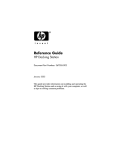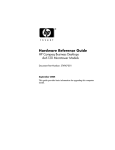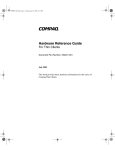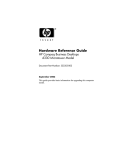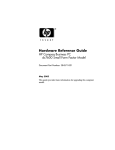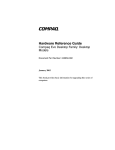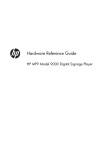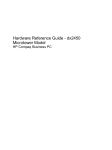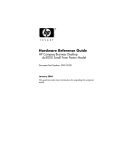Download HP hp 355856-001 User's Manual
Transcript
Hardware Reference Guide HP Compaq Business Desktop d228 and d248 Microtower Document Part Number: 355856-001 November 2003 This guide provides basic information about upgrading this series of computers. © Copyright 2003 Hewlett-Packard Development Company, L.P. The information contained herein is subject to change without notice. Microsoft, MS-DOS, Windows, and Windows NT are trademarks of Microsoft Corporation in the U.S. and other countries. Intel, Pentium, Intel Inside, and Celeron are trademarks of Intel Corporation in the U.S. and other countries. Adobe, Acrobat, and Acrobat Reader are trademarks or registered trademarks of Adobe Systems Incorporated. The only warranties for HP products and services are set forth in the express warranty statements accompanying such products and services. Nothing herein should be construed as constituting an additional warranty. HP shall not be liable for technical or editorial errors or omissions contained herein. This document contains proprietary information that is protected by copyright. No part of this document may be photocopied, reproduced, or translated to another language without the prior written consent of Hewlett-Packard Company. Å WARNING: Text set off in this manner indicates that failure to follow directions could result in bodily harm or loss of life. Ä CAUTION: Text set off in this manner indicates that failure to follow directions could result in damage to equipment or loss of information. Hardware Reference Guide HP Compaq Business Desktop d228 and d248 Microtower TFirst Edition (November 2003) Document Part Number: 355856-001 Contents 1 Hardware Upgrades Serviceability Features . . . . . . . . . . . . . . . . . . . . . . . . . . . . . . . . . . . . . . . . . . . . . . . . . 1–1 Warnings and Cautions . . . . . . . . . . . . . . . . . . . . . . . . . . . . . . . . . . . . . . . . . . . . . . . . . 1–2 Removing the Access Panel and the Front Bezel . . . . . . . . . . . . . . . . . . . . . . . . . . . . . 1–2 Removing Front Drive Bezels . . . . . . . . . . . . . . . . . . . . . . . . . . . . . . . . . . . . . . . . . . . . 1–5 5.25” Drive Bezel Blank . . . . . . . . . . . . . . . . . . . . . . . . . . . . . . . . . . . . . . . . . . . . . 1–5 Diskette Drive Bezel. . . . . . . . . . . . . . . . . . . . . . . . . . . . . . . . . . . . . . . . . . . . . . . . 1–6 Installing Additional Memory . . . . . . . . . . . . . . . . . . . . . . . . . . . . . . . . . . . . . . . . . . . 1–7 DIMMs . . . . . . . . . . . . . . . . . . . . . . . . . . . . . . . . . . . . . . . . . . . . . . . . . . . . . . . . . . 1–7 DDR-SDRAM DIMMs. . . . . . . . . . . . . . . . . . . . . . . . . . . . . . . . . . . . . . . . . . . . . . 1–7 Single Channel and Dual Channel Modes . . . . . . . . . . . . . . . . . . . . . . . . . . . . . . . 1–8 Installing Memory Modules . . . . . . . . . . . . . . . . . . . . . . . . . . . . . . . . . . . . . . . . . . 1–9 Installing an Expansion Card . . . . . . . . . . . . . . . . . . . . . . . . . . . . . . . . . . . . . . . . . . . 1–11 Replacing or Upgrading a Drive . . . . . . . . . . . . . . . . . . . . . . . . . . . . . . . . . . . . . . . . . 1–13 Drive Positions . . . . . . . . . . . . . . . . . . . . . . . . . . . . . . . . . . . . . . . . . . . . . . . . . . . 1–14 Removing a 5.25” Drive . . . . . . . . . . . . . . . . . . . . . . . . . . . . . . . . . . . . . . . . . . . 1–15 Removing a Diskette Drive. . . . . . . . . . . . . . . . . . . . . . . . . . . . . . . . . . . . . . . . . . 1–16 Removing the Lower Drive Cage . . . . . . . . . . . . . . . . . . . . . . . . . . . . . . . . . . . . . 1–17 Removing a 3.5” Hard Drive . . . . . . . . . . . . . . . . . . . . . . . . . . . . . . . . . . . . . . . . 1–19 2 Battery Replacement Replacing the Battery . . . . . . . . . . . . . . . . . . . . . . . . . . . . . . . . . . . . . . . . . . . . . . . . . . 2–1 3 Routine Care & Shipping Information Routine Care . . . . . . . . . . . . . . . . . . . . . . . . . . . . . . . . . . . . . . . . . . . . . . . . . . . . . . . . . Optical Disk Drive Precautions . . . . . . . . . . . . . . . . . . . . . . . . . . . . . . . . . . . . . . . . . . . Operation . . . . . . . . . . . . . . . . . . . . . . . . . . . . . . . . . . . . . . . . . . . . . . . . . . . . . . . . Cleaning . . . . . . . . . . . . . . . . . . . . . . . . . . . . . . . . . . . . . . . . . . . . . . . . . . . . . . . . . Safety . . . . . . . . . . . . . . . . . . . . . . . . . . . . . . . . . . . . . . . . . . . . . . . . . . . . . . . . . . . Shipping Preparation . . . . . . . . . . . . . . . . . . . . . . . . . . . . . . . . . . . . . . . . . . . . . . . . . . . Hardware Reference Guide 3–1 3–2 3–2 3–2 3–2 3–3 iii Contents 4 Electrostatic Discharge Preventing Electrostatic Damage . . . . . . . . . . . . . . . . . . . . . . . . . . . . . . . . . . . . . . . . . 4–1 Grounding Methods. . . . . . . . . . . . . . . . . . . . . . . . . . . . . . . . . . . . . . . . . . . . . . . . . . . . 4–2 Index iv Hardware Reference Guide 1 Hardware Upgrades HP Compaq d228, d230, and d248 Microtower Serviceability Features The Microtower computer includes features that make it easy to upgrade and service. No tools are needed for most of the installation procedures described in this chapter. Hardware Reference Guide 1–1 Hardware Upgrades Warnings and Cautions Before performing upgrades be sure to carefully read all of the applicable instructions, cautions, and warnings in this guide. Å WARNING: To reduce the risk of personal injury from electrical shock and/or hot surfaces, be sure to disconnect the power cord from the wall outlet and allow the internal system components to cool before touching. Å WARNING: To reduce the risk of electrical shock, fire, or damage to the equipment, do not plug telecommunications/telephone connectors into the network interface controller (NIC) receptacles. Ä CAUTION: Static electricity can damage the electrical components of the computer or optional equipment. Before beginning these procedures, ensure that you are discharged of static electricity by briefly touching a grounded metal object. See Chapter 4, “Electrostatic Discharge” for more information. Ä CAUTION: Before removing the computer cover, ensure that the computer is turned off and that the power cord is disconnected from the electrical outlet. Removing the Access Panel and the Front Bezel 1. Turn off the computer properly through the operating system and turn off any external devices. 2. Disconnect the power cord from the power outlet and the computer, and disconnect any external devices. 3. Remove the two screws that secure the access panel to the computer chassis. Some access panels use captive thumbscrews. the right access panel to upgrade memory or an expansion ✎ Remove card. Remove the left access panel to upgrade a drive. 1–2 Hardware Reference Guide Hardware Upgrades 4. Slide the access panel back about 1 inch (2.5 cm), then lift it away from and off the unit. Removing the Access Panels To replace the access panel, reverse the removal steps. two access panels are physically identical. One access panel has ✎ The captive thumbscrews that may be removed by unscrewing them. Hardware Reference Guide 1–3 Hardware Upgrades 5. To remove the front bezel, grasp the bottom of the front panel below the lowest air vent and pull the panel out and up to release it from the chassis. Removing the Front Bezel To install the front bezel, insert the top two latches into their respective holes in the chassis and push the bezel in until it is fully seated. replacing the front bezel, ensure that the top of the front bezel ✎ When is flush with the top of the chassis before pressing it into place. 1–4 Hardware Reference Guide Hardware Upgrades Removing Front Drive Bezels 1. Turn off the computer properly through the operating system and turn off any external devices. 2. Disconnect the power cord from the power outlet and the computer, and disconnect any external devices. 3. Remove the access panel. 4. Remove the front bezel. 5.25” Drive Bezel Blank Press one of the retaining tabs on the inside of the large bezel towards the outer edge of the bezel to release the bezel blank. At the same time, pull the bezel blank inwards to remove it from the main bezel. Removing the Bezel Blank To install a bezel blank, reverse the removal procedure. Hardware Reference Guide 1–5 Hardware Upgrades Diskette Drive Bezel on the computer configuration, you may have a bezel ✎ Depending blank in this position. If you do not have a drive in this slot, you may choose to install a 3.5-inch device (such as a diskette drive, hard drive, or Zip drive) later on. Pull the right retaining tab towards the center of the main bezel. At the same time, pull the bezel inwards to remove it from the main bezel. Removing the Bezel Blank To install a diskette drive bezel, reverse the removal procedure. 1–6 Hardware Reference Guide Hardware Upgrades Installing Additional Memory The computer comes with Double Data Rate-Synchronous Dynamic Random Access Memory (DDR-SDRAM) Dual Inline Memory Modules (DIMMs). DIMMs The memory sockets on the system board can be populated with industry-standard DIMMs. These memory module slots are populated with at least one preinstalled memory module. To achieve the maximum memory support, you may be required to replace the preinstalled DIMM with a higher capacity DIMM. The HP Compaq d228 and d230 Microtower system boards can be populated with up to 2GB of memory and support single-channel mode. The HP Compaq d248 Microtower system board can be populated with up to 4GB of memory and supports single-channel or dual-channel mode. more information about single-channel or dual-channel memory ✎ For modes, see the section “Single Channel and Dual Channel Modes” on page 8. DDR-SDRAM DIMMs For proper system operation, if the computer supports DDR-SDRAM DIMMs, the DIMMs must be: ■ industry-standard 184-pin ■ unbuffered PC2100 266 MHz-, PC2700 333 MHz-, or PC3200 400 MHz-compliant the HP Compaq d248 Microtower supports PC3200 400 ✎ Only MHz-compliant DIMMS. ■ 2.5 volt DDR-SDRAM DIMMs. The DDR-SDRAM DIMMs must also: ■ Hardware Reference Guide support CAS latency 2, 2.5, or 3 (CL = 2, CL = 2.5, or CL = 3) 1–7 Hardware Upgrades ■ contain the mandatory JEDEC SPD information In addition, the computer supports: ■ 128Mbit, 256Mbit, and 512Mbit non-ECC memory technologies ■ single-sided and double-sided DIMMS ■ DIMMs constructed with x8 and x16 DDR devices; DIMMs constructed with x4 SDRAM are not supported Maximum operating speed is determined by a combination of the CPU and type of memory used. Refer to the table below for the optimum combination. Maximum Front Side Bus Operating Speed (MHz) CPU Front Side Bus (MHz) DDR266 DIMM DDR333 DIMM DDR400 DIMM 400 266 266 266 533 266 333 333 800 (d248 only) 266 320 400 ✎ The system will not start if you install unsupported DIMMs. Single Channel and Dual Channel Modes HP Compaq d228 and d230 Microtower models operate in single channel mode. HP Compaq d248 Microtower models will automatically operate in single channel mode or a higher-performing dual channel mode, depending on how the DIMMs are installed. 1–8 ■ In single channel mode, the maximum operational speed is determined by the slowest DIMM in the system. For example, if the system is populated with a DIMM that is 266 MHz and a second DIMM that is 333 MHz, the system will run at the slower of the two speeds. ■ In dual channel mode (d248 models only), all DIMMs must be identically matched. DIMMs in the J23 and J24 sockets must be identical; DIMMs in the J25 and J28 sockets must also be Hardware Reference Guide Hardware Upgrades identical. Therefore, if you have one preinstalled DIMM in socket J23 and are adding a second DIMM, it is recommended that you install an identical DIMM into the J25 socket. If you are populating all four DIMM sockets, use identical DIMMs in each socket. Otherwise, the system will not operate in dual channel mode. There are two DIMM sockets on the HP Compaq d228 and d230 Microtower system board, operating in single-channel mode. There are four DIMM sockets on the HP Compaq d248 Microtower system board, operating in either single- or dual-channel mode, with two sockets per channel. The sockets are labeled J23, J24, J25, and J28. Sockets J23 and J24 operate in memory channel A. Sockets J25 and J28 operate in memory channel B. Installing Memory Modules Ä CAUTION: The memory module sockets have gold metal contacts. When upgrading the memory, it is important to use memory modules with gold metal contacts to prevent corrosion and/or oxidation resulting from having incompatible metals in contact with each other. Ä CAUTION: Static electricity can damage the electronic components of the computer or optional cards. Before beginning these procedures, ensure that you are discharged of static electricity by briefly touching a grounded metal object. Refer to Chapter 5 for more information. Ä CAUTION: When handling a memory module, be careful not to touch any of the contacts. Doing so may damage the module. 1. Turn off the computer properly through the operating system and turn off any external devices. 2. Disconnect the power cord from the power outlet and the computer, and disconnect any external devices. there is a hard drive in bay 5 it will be necessary to remove the ✎ Iflower drive cage before removing the memory modules. 3. Remove the right access panel. Hardware Reference Guide 1–9 Hardware Upgrades Å WARNING: To reduce risk of personal injury from hot surfaces, allow the internal system components to cool before touching. 4. Lay the computer down on its side to make it easier to work on. 5. Open both latches of the memory module socket 1, and insert the memory module into the socket 2. Begin by installing a module into the socket nearest the preinstalled module, and install the modules following the numerical order of the sockets. Installing a Memory Module module can be installed in only one way. Match the notch ✎ Aonmemory the module with the tab on the memory socket. 6. Push the module down into the socket, ensuring that the module is fully inserted and properly seated. Make sure the latches are in the closed position 3. 7. Repeat steps 5 and 6 for any additional modules that you want to install. To reassemble the computer, reverse the removal procedure. 1–10 Hardware Reference Guide Hardware Upgrades Installing an Expansion Card 1. Turn off the computer properly through the operating system and turn off any external devices. 2. Disconnect the power cord from the power outlet and the computer, and disconnect any external devices. 3. Remove the right access panel. 4. Lay the computer down on its side to make it easier to work on. If installing an expansion card in an empty slot, skip to step 10. 5. To remove an expansion card, disconnect any cables attached to the expansion card. 6. Remove the screw at the top of the expansion slot. 7. Hold the card at each end and carefully rock it back and forth until the connectors pull free from the socket. Be sure not to scrape the card against other components. 8. Store the card in anti-static packaging. 9. Install a new expansion card or an expansion slot cover to close the open slot. Ä Hardware Reference Guide CAUTION: After removing an expansion card, you must replace it with a new card or cover the open slot (for example, with a metal slot cover or a piece of duct tape) for proper cooling of internal components during operation. 1–11 Hardware Upgrades If not installing an additional expansion card, skip to step 12. 10. Remove the expansion slot cover. 11. Slide the expansion card into the expansion socket and press it firmly into place. Installing an Expansion Card you install an expansion card, make sure you press firmly on ✎ When the card so that the entire connector seats properly in the expansion card socket. 12. Install the screw at the top of the expansion slot to further secure the part in the chassis. 13. Replace the access panel. 14. Connect external cables to the installed card, if needed. Reconfigure the computer, if necessary. 1–12 Hardware Reference Guide Hardware Upgrades Replacing or Upgrading a Drive The computer supports up to five drives that may be installed in various configurations. This Section describes the procedure for replacing or upgrading the storage drives. A Torx T-15 screwdriver is needed to remove and install the guide screws on a drive. Ä Hardware Reference Guide CAUTION: Make sure personal files on the hard drive are backed up to an external storage device before removing the hard drive. Failure to do so will result in data loss. After replacing the primary hard drive, you will need to run the Restore Plus! CD to load the Compaq factory-installed files. 1–13 Hardware Upgrades Drive Positions Drive Positions Description Description 1 2 5.25-inch drive bay for optional drives* 3 3.5-inch drive bay (1.44-MB diskette drive shown)** 4 5 3.5-inch, internal, standard hard drive bay *An optional drive is a CD-ROM, CD-R/RW, DVD-ROM, DVD-R/RW, or CD-RW/DVD Combo drive. **Depending on the computer configuration, you may have a bezel blank in this position. If you do not have a drive in this slot, you may choose to install a 3.5-inch device (such as a diskette drive, hard drive, or Zip drive) later on. 1–14 Hardware Reference Guide Hardware Upgrades Removing a 5.25” Drive 1. Turn off the computer properly through the operating system and turn off any external devices. 2. Disconnect the power cord from the power outlet and the computer, and disconnect any external devices. 3. Remove both the right and left access panels. 4. Remove the front bezel. 5. Disconnect the power, data, and audio cables, as necessary, from the back of the drive. it may be easier to slide the drive part way out of the ✎ Indrivesomebaycases before removing the cables. 6. Remove the four screws, two from each side, that secure the drive in the drive cage 1. 7. Slide the drive out of the drive cage, as shown in the illustration below 2. Removing a 5.25” Drive Hardware Reference Guide 1–15 Hardware Upgrades To install a drive, reverse the removal procedure. are installing a 5.25” drive for the first time into bay 2 you must ✎ Iffirstyouremove the drive from bay 1 and then knock or pry out the metal shield that covers the front of bay 2. Å WARNING: There may be sharp edges on the inside of the bay opening after the shield has been removed. Removing a Diskette Drive 1. Turn off the computer properly through the operating system and turn off any external devices. 2. Disconnect the power cord from the power outlet and the computer, and disconnect any external devices. 3. Remove both the right and left access panels. 4. Remove the front bezel. 5. Disconnect the power, and data cables from the back of the drive. 1–16 Hardware Reference Guide Hardware Upgrades 6. Remove the four screws, two from each side, that secure the drive in the drive cage 1. 7. Slide the drive out of the front of the chassis 2. Removing a Diskette Drive To replace the diskette drive, reverse removal procedure. Removing the Lower Drive Cage 1. Turn off the computer properly through the operating system and turn off any external devices. 2. Disconnect the power cord from the power outlet and the computer, and disconnect any external devices. 3. Remove both the right and left access panels. 4. Remove the front bezel. 5. Remove the diskette drive. 6. Disconnect the power, and data cables from the back of all installed 3.5” drives. Hardware Reference Guide 1–17 Hardware Upgrades 7. Remove the four screws that secure the drive cage to the front of the chassis 1 and then remove the single screw that attaches the lower drive cage to the fixed upper drive cage on the right side of the chassis 2. HP Compaq d248 Microtower has 3 screw securing the drive ✎ The cage to the front of the chassis. 8. Slide the lower drive cage back about 1/2 inch to release it from the upper cage 3. Removing the Lower Drive Cage To install the lower drive cage, reverse the removal procedure. Ä 1–18 CAUTION: When installing the retaining screws always use the short (5/32” long) screw in the side mounting position and the 4 longer screws on the front of the chassis. Hardware Reference Guide Hardware Upgrades Removing a 3.5” Hard Drive 1. Turn off the computer properly through the operating system and turn off any external devices. 2. Disconnect the power cord from the power outlet and the computer, and disconnect any external devices. 3. Remove both the right and left access panels. 4. Remove the front bezel. 5. Remove the diskette drive. 6. Disconnect the power, and data cables from the back of all installed 3.5” drives. 7. Remove the lower drive cage. 8. Remove the four screws, two from each side, that secure the drive in the drive cage. 9. Slide the drive out of the drive cage. Removing a 3.5” Hard Drive To replace the drive cage, reverse the removal procedure. Hardware Reference Guide 1–19 Hardware Upgrades 1–20 Hardware Reference Guide 2 Battery Replacement Replacing the Battery The battery that comes with your computer provides power to the real-time clock and has a lifetime of about three years. When replacing the battery, use a battery equivalent to the battery originally installed on the computer. The computer comes with a 3-volt lithium coin cell battery. lifetime of the lithium battery can be extended by plugging the ✎ The computer into a live AC wall socket. The lithium battery is only used when the computer is NOT connected to AC power. Å WARNING: This computer contains an internal lithium manganese dioxide battery. There is a risk of fire and burns if the battery is not handled properly. To reduce the risk of personal injury: ■ ■ ■ ■ Ä Hardware Reference Guide Do not attempt to recharge the battery. Do not expose to temperatures higher than 140°F (60°C) Do not disassemble, crush, puncture, short external contacts, or dispose of in fire or water. Replace the battery only with the HP/Compaq spare designated for this product. CAUTION: Before replacing the battery, it is important to back up the computer CMOS settings. When the battery is removed or replaced, the CMOS settings will be cleared. 2–1 Battery Replacement N Batteries, battery packs, and accumulators should not be disposed of together with the general household waste. In order to forward them to recycling or proper disposal, please use the public collection system or return them to HP/Compaq, their authorized partners, or their agents. Ä CAUTION: Static electricity can damage the electronic components of the computer or optional equipment. Before beginning these procedures, ensure that you are discharged of static electricity by briefly touching a grounded metal object. 1. Prepare the computer for disassembly. 2. Remove the right access panel. may be necessary to remove an expansion card to gain access to the ✎ Itbattery. 3. Locate the battery and battery holder on the system board. 4. Depending on the type of battery holder on your system board, complete the following instructions to replace the battery: 2–2 Hardware Reference Guide Battery Replacement Type 1: a. To release the battery from its holder, squeeze the metal clamp that extends above one edge of the battery. b. When the battery pops up, lift it out. Removing a Type 1 Battery Hardware Reference Guide 2–3 Battery Replacement c. To insert the new battery, slide one edge of the replacement battery under the holder’s lip with the positive side up. Push the other edge down until the clamp snaps over the other edge of the battery. Inserting a Type 1 Battery 2–4 Hardware Reference Guide Battery Replacement Type 2: a. To release the battery from its holder, push the retaining clip that holds the battery in place 1. a. Lift the battery out of its holder 2. Removing a Type 2 Battery b. Slide the replacement battery into position. The battery holder automatically secures the battery in the proper position. the battery has been replaced, use the following steps to ✎ After complete this procedure. 5. Replace the computer cover or access panel. 6. Plug in the computer and turn on power to the computer. Reset the date and time, your passwords, and any special system setups, using Computer Setup. Refer to the Computer Setup (F10) Utility Guide. Hardware Reference Guide 2–5 Battery Replacement 2–6 Hardware Reference Guide 3 Routine Care & Shipping Information Routine Care Follow these suggestions to take care of your personal computer and monitor: Hardware Reference Guide ■ Operate the personal computer on a sturdy, level surface. Leave a 3-inch (7.6-cm) clearance at the back of the system unit and above the monitor to permit the required airflow. ■ Never operate the personal computer with the cover or side panel removed. ■ Never restrict the airflow into the personal computer by blocking the air intake or exhaust vents. ■ Keep the personal computer away from excessive moisture, direct sunlight, and extremes of heat and cold. ■ Keep liquids away from the personal computer and keyboard. ■ Never cover the ventilation slots on the monitor with any type of material. ■ Turn off the personal computer before you do either of the following: ❏ Wipe the exterior of the personal computer with a soft, damp cloth as needed. Using cleaning products may discolor or damage the finish. ❏ Occasionally clean the air intake and exhaust vents on the personal computer. Lint and other foreign matter can block the vents and limit the airflow. 3–1 Routine Care & Shipping Information Optical Disk Drive Precautions Be sure to observe the following guidelines while operating or cleaning your optical disk drive. Operation ■ Do not move the drive during operation. This may cause it to malfunction during reading. ■ Avoid exposing the drive to sudden changes in temperature, as condensation may form inside the unit. If the temperature suddenly changes while the drive is on, wait at least one hour before you turn off the power. If you operate the unit immediately, it may malfunction while reading. ■ Avoid placing the drive in a location that is subject to high humidity, extreme temperatures, mechanical vibration, or direct sunlight. ■ Clean the panel and controls with a soft, dry cloth or a soft cloth lightly moistened with a mild detergent solution. Never spray cleaning fluids directly on the unit. ■ Avoid using any type of solvent, such as alcohol or benzene, which may damage the finish. Cleaning Safety If any object or liquid falls into the drive, immediately unplug the personal computer and have it checked by an authorized HP service provider. 3–2 Hardware Reference Guide Routine Care & Shipping Information Shipping Preparation Follow these suggestions when preparing to ship your personal computer: 1. Back up the hard drive files onto the network or removable media. Be sure that the backup media is not exposed to electrical or magnetic impulses while stored or in transit. hard drive locks automatically when the system power is turned ✎ The off. 2. Remove and store separately any removable media and MultiBay drives. 3. Turn off the personal computer and external devices. 4. Disconnect the power cord from the electrical outlet, then from the personal computer. 5. Pack the system components, MultiBay drives, and external devices in their original packing boxes or similar packaging with sufficient packing material to protect them. Hardware Reference Guide 3–3 Routine Care & Shipping Information 3–4 Hardware Reference Guide 4 Electrostatic Discharge A discharge of static electricity from a finger or other conductor may damage system boards or other static-sensitive devices. This type of damage may reduce the life expectancy of the device. Preventing Electrostatic Damage To prevent electrostatic damage, observe the following precautions: Hardware Reference Guide ■ Avoid hand contact by transporting and storing products in static-safe containers. ■ Keep electrostatic-sensitive parts in their containers until they arrive at static-free workstations. ■ Place parts on a grounded surface before removing them from their containers. ■ Avoid touching pins, leads, or circuitry. ■ Always be properly grounded when touching a static-sensitive component or assembly. 4–1 Electrostatic Discharge Grounding Methods There are several methods for grounding. Use one or more of the following methods when handling or installing electrostatic-sensitive parts: ■ Use a wrist strap connected by a ground cord to a grounded workstation or computer chassis. Wrist straps are flexible straps with a minimum of 1 Megaohm +/- 10 percent resistance in the ground cords. To provide proper ground, wear the strap snug against the skin. ■ Use heelstraps, toestraps, or bootstraps at standing workstations. Wear the straps on both feet when standing on conductive floors or dissipating floor mats. ■ Use conductive field service tools. ■ Use a portable field service kit with a folding static-dissipating work mat. If you do not have any of the suggested equipment for proper grounding, contact your HP authorized dealer, reseller, or service provider. more information on static electricity, contact your HP authorized ✎ For dealer, reseller, or service provider. 4–2 Hardware Reference Guide Index B battery Type 1, removal and replacement 2–3 Type 2, removal and replacement 2–5 C care of equipment 3–1 CD-ROM drive cleaning and safety 3–2 D drive 3.5" drive removal 1–19 removal and replacement 1–15 drive positions 1–14 E electrostatic discharge grounding methods 4–2 preventing damage 4–1 expansion slot cover Hardware Reference Guide replacing 1–11 M memory dual channel mode 1–8 removal and replacement 1–7 specifications 1–7 P packaging guidelines 3–3 R removal and replacement 3.5" drive 1–19 drive 1–15 memory 1–7 Type 1 battery 2–3 Type 2 battery 2–5 S shipping guidelines 3–3 Index–1 Index Index–2 Hardware Reference Guide






































